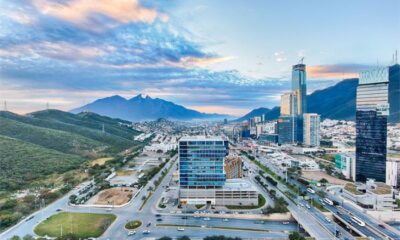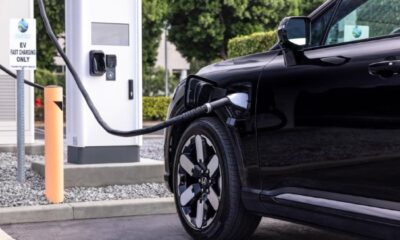Technology
Ericsson to Build Next-Generation Smart Manufacturing and Technology Hub in Europe

- New next-generation smart manufacturing and technology hub in Europe will serve as a collaborative space for co-developing new cellular ecosystems and production techniques
- Merging all facilities in Tallinn, Estonia into one site will reduce environmental impact and support Ericsson’s Net Zero journey via sustainable operations that cut carbon emissions
- The 50,000-square meter European hub is expected to be operational in early 2026
Ericsson (NASDAQ: ERIC) has set its sights on leading innovation in Europe by building a next-generation smart manufacturing and technology hub in Tallinn, Estonia. The new facility, a green field investment valued at about EUR 155 million (USD 169 million), has sustainability and operational efficiency top of mind.
The plan is to consolidate all of Ericsson’s operations in Estonia into a single, state-of-the art, 50,000 sq m smart hub that comprises test labs, warehouses, production lines, and offices. It will be used for co-developing cellular ecosystems and production techniques mainly with customers and partners in Europe but with global impact on industrialization for volume production. By establishing this European hub, Ericsson will enable a symbiotic relationship between its established R&D in Sweden and manufacturing, where product innovation extends into production and vice versa.
As a first step towards this goal Ericsson, through its Estonian affiliate, has signed a definitive agreement to acquire property to build this smart hub with the transaction expected to close in the fourth quarter of 2024, subject to agreed conditions.
The fully connected hub will be located in Ülemiste City in Tallinn, the largest business park and future-oriented urban area in the Baltics. The new European hub is expected to be operational in early 2026, with Ericsson’s ambitions of it becoming LEED* Gold-certified during the same year.
Fredrik Jejdling, Executive Vice President and Head of Networks, Ericsson, says: “This move is in line with Ericsson’s long-term strategy for a more resilient and sustainable supply chain, significantly reducing our carbon footprint and harnessing the power of 5G for smart manufacturing. Our entire production landscape globally is being digitalized and, as we have done in the U.S., this will strengthen the link between our R&D and new product introduction to ensure every product we manufacture not only benefits our customers but are also produced with as low environmental impact as possible.”
The new European hub is expected to reduce its carbon emissions by up to 70 percent compared to all four existing facilities in Tallinn. It will support Ericsson’s 2030 target to be Net Zero in its own operations through highly sustainable and energy-efficient design including the use of low embodied carbon wooden glulam beams, ensuring structural strength while minimizing environmental impact, and a solar farm on the roof.
Ericsson is also supporting communications service providers (CSPs) in their Net Zero journeys with the most energy-efficient portfolio in the market. By upgrading existing 4G sites to 5G, CSPs can increase their network capacity by up to 10 times while reducing energy consumption by more than 30 percent.
“We are committed to being at the forefront of sustainable operations in Europe as we revolutionize our manufacturing process jointly with our partners and customers, and support the scale up of 5G deployment,” Jejdling says. “This smart hub will be powered 100 percent by renewable electricity and built with optimal efficiency through AI, machine learning, robotics, and other advanced Industry 4.0 technologies. In addition, we aim to attract local and European talent by creating an environment that fosters collaboration, innovation, employee wellbeing, diversity, and inclusion.”
Ericsson has currently more than 2,200 employees in Estonia, including engineers and experts in AI and machine learning. The existing factory plays a strategic role in Ericsson’s global supply footprint, accounting for more than 40 percent of the industrialization of Ericsson 5G products.
Tiit Riisalo, Minister of Economic Affairs and Information Technology of Estonia, says: “Ericsson’s decision to establish a high-tech, smart manufacturing and technology hub in the forward-looking Ülemiste City, stands as a prime illustration of the economy’s next generation for Estonia. It serves as a concrete demonstration of Estonia’s commitment to the green transition, our robust ties to emerging technologies, and the creation of an ecosystem that fosters innovation for other companies as well.”
Source – Ericsson
-

 Auto2 years ago
Auto2 years agoHonda Marine Debuts All-New BF350 Outboard Company’s First V8 Motor Available Commercially, Flagship Model Offers Premium Power and Unparalleled Performance for Extraordinary Boating Experiences
-

 Auto2 years ago
Auto2 years agoNew Features Further Increase Desirability Of Bentayga Range
-

 Technology1 year ago
Technology1 year agoOracle Partners with TELMEX-Triara to Become the Only Hyperscaler with Two Cloud Regions in Mexico
-

 Auto1 year ago
Auto1 year agoHonda and Acura Electric Vehicles Will Have Access to Largest EV Charging Networks in North America Aided by New Agreements with EVgo and Electrify America
-

 Lifestyle2 years ago
Lifestyle2 years ago2023 Nike World Basketball Festival Brings the Best of Basketball Style, Culture and Community














